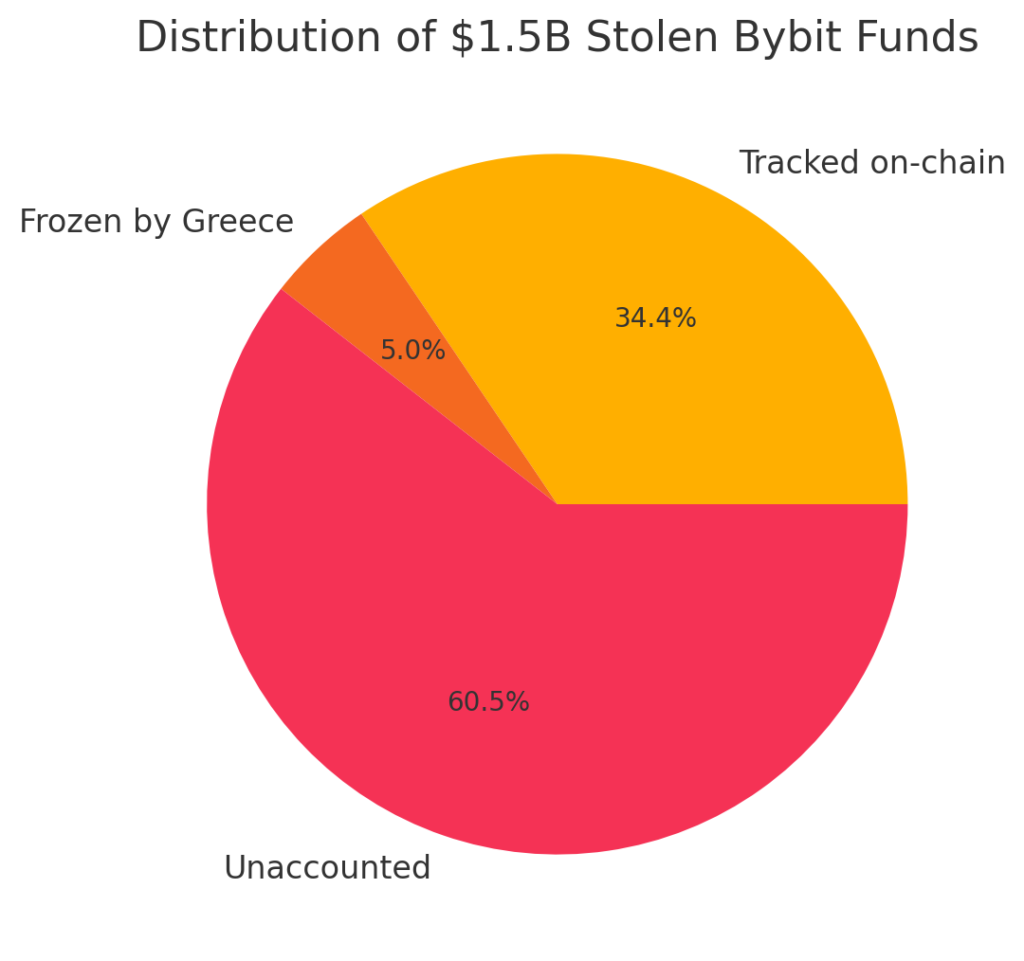
Main Points:
- Record Heist: In February 2025, North Korea’s Lazarus Group exploited a vulnerability in Bybit’s multisig cold wallet, draining approximately $1.5 billion in ETH, mETH, and stETH.
- Early Laundering Hubs: Much of the loot—over 60%—remains unaccounted for, laundered through mixers and shadow platforms like eXch.
- German Crackdown: In May, German authorities shut down the eXch platform, seizing €34 million (about $38 million) linked to the hack.
- Greek First: On July 9, Greece executed its inaugural crypto seizure, freezing $72 million (5% of the stolen funds) using Chainalysis Reactor analytics.
- International Cooperation: U.S., Japan, and South Korea reaffirmed joint efforts against North Korean crypto theft in January 2025, signaling more coordinated future actions.
Background: The Bybit Breach and Lazarus’s Modus Operandi
In late February 2025, attackers attributed to North Korea’s notorious Lazarus Group breached Bybit’s multi-signature cold wallet, siphoning 401,346 ETH along with mETH and stETH—equivalent to roughly $1.5 billion at the time. Multisig wallets, designed for enhanced security by requiring multiple private keys, were thought to be invulnerable; instead, the hackers exploited either key mismanagement or supply-chain flaws in Bybit’s cold-storage process. This incident eclipsed previous records, nudging the crypto industry to re-examine the very foundations of exchange security.
Early Laundering: eXch and the Shadow Economy
In the aftermath, chain sleuths observed large transfers flowing into obscure crypto platforms and mixers, chief among them Germany-based eXch. Active since 2014 with advertised “anonymous swaps,” eXch became a go-to laundering hub, mixing stolen ETH before converting portions into Bitcoin and other tokens. By May 9, 2025, Germany’s Federal Criminal Police Office (BKA) raided eXch’s servers, seizing €34 million ($38 million) in various cryptocurrencies and 8 TB of forensic data, revealing that eXch handled over $1.9 billion in illicit funds, including parts of the Bybit haul.
Piecing Together the Loot: A Visual Breakdown
As of mid-2025, investigators have broken down the $1.5 billion as follows:
- Tracked on-chain: ~$495 million (33%)
- Frozen by Greece: ~$72 million (5%)
- Unaccounted: ~$870 million (62%)

Refer to the chart and table above for an at-a-glance view of fund allocation and the timeline of key events.
Greece’s Groundbreaking Seizure
On July 9, 2025, the Hellenic Anti-Money Laundering Authority issued a freezing order on a wallet tied to the initial theft, marking Greece’s first-ever crypto asset seizure. Leveraging Chainalysis Reactor, Greek investigators linked suspicious on-chain activity from 2023 onward to the February hack. The freeze immobilizes $72 million, preventing further dispersal and transferring control to prosecutorial authorities.
How Chainalysis Reactor Made the Difference
- Deep-link tracing: Mapping cross-chain movements and wallet clusters.
- Entity attribution: Pinpointing service providers and mixing platforms.
- Real-time alerts: Flagging anomalous transactions as they occurred.
This landmark operation illustrates how robust analytics tools can turn the tide against sophisticated state-backed hacking groups.
Challenges Ahead: The 62% Gap
Despite these successes, roughly $870 million of the stolen funds remain elusive. Hackers continue to exploit decentralized exchanges, privacy-focused mixers, and multi-hop bridging protocols. As anonymity tools evolve—zero-knowledge proofs, time-locked mixers—the difficulty of recovery will intensify.
Fragmented Jurisdictions and Cooperation
- Regulatory mismatches: Varying AML rules and crypto licensing regimes across the EU hinder unified responses.
- Information sharing: While chain analytics firms offer global visibility, legal frameworks for cross-border evidence gathering lag.
- Political will: Seizures require high-level directives; without cohesive international mandates, many frozen assets languish in legal limbo.
Looking Forward: Tech and Policy Innovations
- Expanded Sanctions: OFAC and EU bodies may broaden designations to choke off on-ramps for Lazarus front platforms.
- Next-gen analytics: AI-infused blockchain tagging could automate real-time threat detection.
- Deeper public-private coalitions: Exchanges, analytics firms, and law enforcement building integrated watch-networks.
These measures could shrink the unaccounted pool and deter future large-scale heists.
Conclusion
The Bybit hack stands as a stark reminder: as crypto matures, its integration with national security concerns deepens. The Greek and German operations demonstrate that, armed with cutting-edge analytics and cross-border cooperation, law enforcement can claw back even the most brazen cyber-thefts. Yet with over 60% of the pilfered $1.5 billion still at large, the battle is far from over. The coming months will test whether the nascent frameworks for crypto crime prevention can evolve rapidly enough to stay ahead of state-level adversaries. For investors and blockchain practitioners, the takeaways are clear: robust self-custody practices, granular AML controls, and support for transparent, regulated intermediaries are no longer optional—they are foundational.

